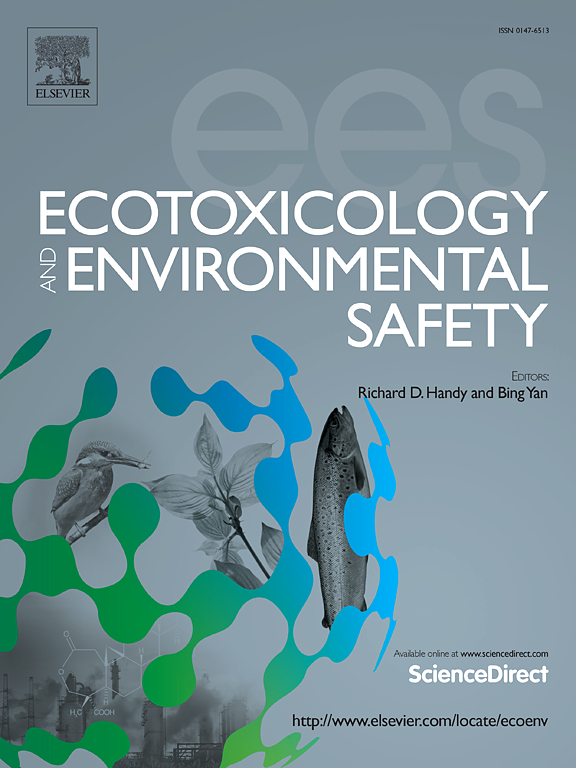亚急性邻苯二甲酸二丁酯暴露损害肝T细胞并促进小鼠肝脏乙型肝炎的进展
IF 6.2
2区 环境科学与生态学
Q1 ENVIRONMENTAL SCIENCES
引用次数: 0
摘要
肝脏免疫微环境通过平衡免疫防御和耐受性来控制肝脏疾病的易感性。虽然邻苯二甲酸酯(PAEs)是塑料衍生的新污染物,已被认为是肝毒性物质,但亚急性接触PAEs的免疫调节和临床影响仍未得到充分探讨。在这项研究中,我们发现邻苯二甲酸二丁酯(DBP)是乙型肝炎病毒(HBV)感染患者肝组织中的主要PAE。基于模拟亚急性DBP暴露特定情景的小鼠模型,单细胞RNA测序和流式细胞术显示DBP显着耗尽肝脏T细胞并诱导功能衰竭。此外,暴露于DBP的hbv携带者小鼠表现出较长时间的病毒持久性,HBsAg清除延迟和肝损伤标志物升高。在DBP暴露的背景下,共培养试验将持续HBV感染与T细胞功能障碍联系起来。流行病学分析进一步将尿DBP代谢物升高与HBV指标阳性升高联系起来。在有HBV感染史的个体中,较高的DBP代谢物水平与肝功能下降有关。总之,我们的研究结果阐明了亚急性DBP暴露通过驱动T细胞衰竭和协同导致肝脏免疫微环境崩溃来加剧HBV进展。因此,我们提出DBP是HBV的促进剂,将亚急性DBP暴露定位为病毒性肝炎的危险因素,倡导在高危人群中监测PAEs,并提出针对免疫衰竭的治疗策略,以减轻PAEs在肝脏疾病中的病毒协同作用。本文章由计算机程序翻译,如有差异,请以英文原文为准。
Subacute dibutyl phthalate exposure impairs hepatic T cells and facilitates hepatitis B progression in mouse liver
The hepatic immune microenvironment governs liver disease susceptibility by balancing immune defense and tolerance. While phthalate esters (PAEs), emerging pollutants derived from plastics, have been acknowledged as hepatoxic substances, the immunomodulatory and clinical impacts of subacute PAEs exposure remain underexplored. In this study, we identified dibutyl phthalate (DBP) as a predominant PAE in liver tissues from hepatitis B virus (HBV)-infected patients. Based on the murine model mimicking specific scenarios of subacute DBP exposure, single-cell RNA sequencing and flow cytometry revealed that DBP significantly depleted hepatic T cells and induced functional exhaustion. Moreover, HBV-carrier mice exposed to DBP sub-acutely exhibited prolonged viral persistence, delayed HBsAg clearance and heightened liver injury markers. The co-culture assays mechanistically linked the persistent HBV infection to T cell dysfunction in the context of DBP exposure. Epidemiological analyses further correlated elevated urinary DBP metabolites with increased positivity of HBV indicators. Among individuals with HBV infection history, higher DBP metabolite levels were associated with reduced liver function. In conclusion, our findings elucidated that subacute DBP exposure exacerbates HBV progression by driving T cell exhaustion and synergistically leading to the collapse of hepatic immune microenvironment. Therefore, we propose DBP as a facilitator of HBV, positioning subacute DBP exposure as risk factors for viral hepatitis, advocating for monitoring of PAEs in high-risk populations and therapeutic strategies targeting immune exhaustion to mitigate PAEs-viral synergism in liver diseases.
求助全文
通过发布文献求助,成功后即可免费获取论文全文。
去求助
来源期刊
CiteScore
12.10
自引率
5.90%
发文量
1234
审稿时长
88 days
期刊介绍:
Ecotoxicology and Environmental Safety is a multi-disciplinary journal that focuses on understanding the exposure and effects of environmental contamination on organisms including human health. The scope of the journal covers three main themes. The topics within these themes, indicated below, include (but are not limited to) the following: Ecotoxicology、Environmental Chemistry、Environmental Safety etc.

 求助内容:
求助内容: 应助结果提醒方式:
应助结果提醒方式:


